As a former British soldier faces charges, here is the background to one of the darkest days of the Troubles
Thu 14 Mar 2019 16.30 GMTLast modified on Thu 14 Mar 2019 19.30 GMT
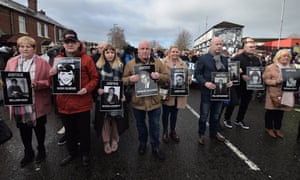
In an atmosphere of heightened tension – but also hope – thousands of men, women and children took to the streets of Derry on 30 January 1972.
Having gathered to protest peacefully about internment, under a new law introduced to detain people without trial indefinitely, the march began shortly after 3pm in the Creggan area and made its way by a circuitous route through the city’s nationalist districts.
The march had been organised under the auspices of the Northern IrelandCivil Rights Association – formed originally as a broad coalition of trade unionists, socialists, nationalists, republicans and others – but was taking place against the backdrop of regular clashes between the security forces and Irish republicans in which firearms had been used by both sides.
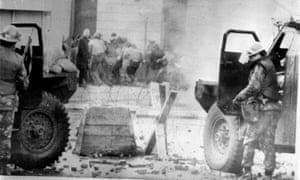
While their intended destination was the Guildhall building in the centre, the marchers were instead directed by the British army towards the landmark of Free Derry Corner. Troops had arrived in force just over two years earlier following violent clashes between civilians and police in 1969.
By 1972 however, the nationalist community had largely turned against the troops, regarding them as being agents of the same oppressive regime as the Royal Ulster Constabulary (RUC), the Northern Irish police force viewed by nationalists as the embodiment of sectarianism.

From the archive, 1 February 1972: Derry’s Bloody Sunday
Read more
On the morning of what would become known as Bloody Sunday, troops from the Parachute Regiment were manning barricades. They were later ordered to move forward to make arrests after skirmishes broke out with young men who had detached from the main protest.
Rubber bullets, teargas and water cannons were used about 4pm as stones were thrown before troops made their way down William Street with orders to arrest as many as possible. A short time later soldiers opened fire around the corner on Rossville Street.
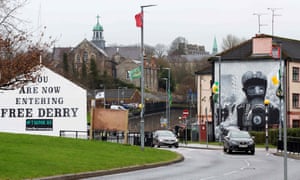
In all, according to army evidence, some 21 soldiers fired 108 live rounds over the course of a day on which 13 people were killed and 15 wounded.
The first casualty of gunfire after soldiers had gone into the nationalist Bogside area of the city in an attempt to make arrests was John Duddy, 17, who was shot and mortally wounded on the western side of the Rossville flats car park.
A photograph of a priest and others carrying the dying teenager – also known as Jackie and one of six 17-year-olds who died – would become one of the most famous images of the Northern Ireland Troubles. The oldest victim was Bernard McGuigan, 41, a father of six children.
McGuigan, who been waving a white handkerchief in his hand, died instantly after he was shot in the head as he went to the aid of Patrick Doherty, a 31-year-old father-of-six who was mortally wounded when he was shot from behind while attempting to crawl to safety.
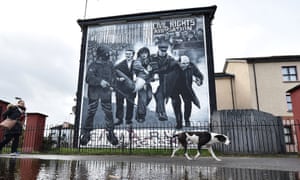
The other dead included Hugh Gilmour, 17, Kevin McElhinney, 17, Michael Kelly, 17, John Young, 17, William Nash,19, and Michael McDaid, 20. All were shot at a rubble barricade on Rossville Street beside the flats.
Four others were killed nearby at Glenfada Park: James Wray, 22, Gerald Donaghy, 17, William McKinney, 27, and Gerald McKinney, a 35-year-old father of eight who was not related to Gerard.
Another man, John Johnston, 59, has long been regarded as the 14th fatality of Bloody Sunday. Although he survived the day, after he was shot twice by soldiers inside a derelict building in William Street, he died months later.
The shootings finally ended at around 4.40pm. The British army claimed that it had come under fire in the Rossville flats areas of the city.
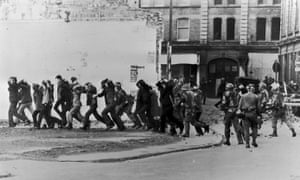
Eyewitnesses insisted that none of the dead were armed, although Lord Saville, who chaired the Bloody Sunday inquiry, found that Gerald Donaghy, a member of the IRA’s youth wing, was “probably” carrying nail bombs. The inquiry was also “sure” that he was not preparing or attempting to throw a bomb when he was shot. His family insisted that the four bombs were planted by the security forces.
It would take two investigations – including one by Lord Widgery that largely cleared the soldiers and authorities of blame – before David Cameron made a formal apology on behalf of the UK government for what had happened on the day.
Since you’re here…
… we have a small favour to ask. More people are reading and supporting The Guardian’s independent, investigative journalism than ever before. And unlike many new organisations, we have chosen an approach that allows us to keep our journalism accessible to all, regardless of where they live or what they can afford. But we need your ongoing support to keep working as we do.
The Guardian will engage with the most critical issues of our time – from the escalating climate catastrophe to widespread inequality to the influence of big tech on our lives. At a time when factual information is a necessity, we believe that each of us, around the world, deserves access to accurate reporting with integrity at its heart.
Our editorial independence means we set our own agenda and voice our own opinions. Guardian journalism is free from commercial and political bias and not influenced by billionaire owners or shareholders. This means we can give a voice to those less heard, explore where others turn away, and rigorously challenge those in power.
We need your support to keep delivering quality journalism, to maintain our openness and to protect our precious independence. Every reader contribution, big or small, is so valuable.